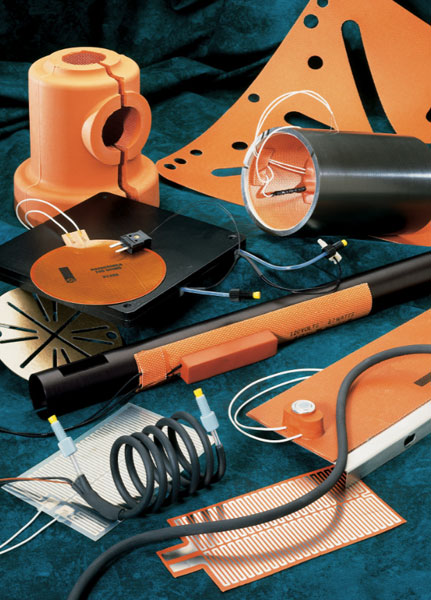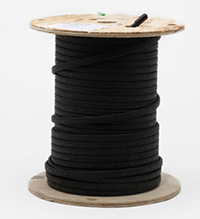Benefits of Flexible Rubber Heaters

There are several key reasons why so many people decide to use flexible rubber heaters. Some of the most common reasons include:
- Silicone rubber is a popular option for outdoor use. It has incredible resistance to the external environment, including rain, snow, and frost. It can also stand up to stress from the ozone and ultraviolet radiation.
- Silicone also has a very low compression set. Even if the heater is compressed for an extended amount of time, it can recover and maintain its original shape. This is useful if the heater is being placed in a confined area.
- Silicone is a polymer, meaning it does not react with other materials. It is incredibly popular throughout the food and beverage industry because it will not react with the products they are near.
- Silicone heaters get hot quickly. You do not have to waste time waiting for them to heat up. Silicone is resistant to heat, so heating to high temperatures is not going to threaten the integrity of the material itself.
- Silicone is one of the lightest materials on the market. This means it is relatively easy to transport, install, and take care of.
- Silicone rubber heaters resist moisture and chemicals with ease. This makes it one of the most versatile options available.
These are just a few of the many benefits that come with using silicone rubber heaters.
BriskHeat Silicone Rubber Heating Blankets
If you are looking for a flexible silicone heater, then you may be interested in silicone rubber heating blankets, such as those from BriskHeat. This blanket is known for its uniform heat distribution, its versatility across numerous environments, and its exceptional durability. It also has an adhesive backing that makes it useful for industrial purposes. There are other heating options you may want to consider as well. These include tote heaters, drum heaters, and even a self-regulating heater cable that gives you more control while increasing safety.
Tempco Silicone Rubber Heaters
You might also want to consider the silicone rubber heaters from Tempco. These heaters come in two separate styles. The first is called a wire wound heater. This type of heater uses wire around elements connected to a fiberglass cord. This is ideal for small or medium quantities of heat. You may want to use wire wound heaters if you are trying to deliver heat to a small, specified area without heating up the surrounding space. The second option is called an etched foil heater. Instead of using wires, the resistance element in this type of heater is a thin metal foil. Because it has a relatively large, flat surface area, it is capable of providing more uniform heat profiles across a larger area. Because this heater is larger, you can use it to heat a larger space without increasing the amount of area taken up by the heater.
Watlow Heaters
If you are looking for some of the best industrial heaters on the market, then you may want to take a closer look at the options provided by Watlow. These heaters have a reputation for being durable, reliable, and easy to use. In addition, they are versatile enough to be used in a variety of ways. Some of the most important information to know about these heaters include:
- They are made from silicone rubber, giving them a thin membrane that allows them to fit just about anywhere.
- They can operate up to a maximum temperature of 260 degrees C, which is 500 degrees F. This gives them a tremendous heat capacity that allows them to operate across numerous industries.
- They can reach a maximum wattage density of 80.
These specifications allow these heaters to operate at a high capacity without sacrificing durability, reliability, or longevity.
Common Applications
There are several common areas where these heaters might be useful. First, they are commonly used to protect liquids and viscous materials against cold temperatures. For example, the heater can be used on metal condensation tanks to keep liquids above their freezing points, protecting the materials. That way, you can reduce the chances of something happening to the materials that might otherwise damage them. These heaters are also commonly used to protect against condensation. They can be placed in confined spaces, preventing condensation on electrical devices that would otherwise destroy them. These heaters can be used to make sure ambient temperatures remain stable, keeping the region above the condensation point of any moisture in the heater itself. This can help you protect valuable equipment from harm. In addition, silicone rubber heaters can be used to prevent corrosion. If condensation builds up on the walls of large tanks and storage areas, corrosion can begin. To prevent this from happening, silicone rubber heaters can be placed on the walls of hoppers and tanks to keep the surface temperatures stable. That way, moisture does not form, and corrosion is no longer a concern. This can help you save money on the cost of repairing damaged tanks or replacing them prematurely. For these reasons, take a closer look at all of the silicone rubber heaters available. Then, if you are having a difficult time figuring out which one is best for your needs, you may want to reach out to a professional who can assist you. They might help you protect your materials. It would be our pleasure to help you find the right silicone heaters to meet your needs. If you reach out to us, we can walk you through the process, helping you find the best option available. We can compare the benefits and drawbacks of each choice, allowing you to make the right decision. Count on our team to assist you. Silicone Rubber Heater Silicone rubber heaters with wire-wound elements provide an excellent source for uniform heat especially on challenging shapes or applications with flexing or vibration.
- Silicone Rubber Wire Wound
- Silicone Etch Foil
- Silicone Rubber Drum
- Silicone Rubber Tote
Silicone Rubber Heater Specifications Physical Size and Construction Limitations
| Maximum Size | Dimensional Tolerance: | Nominal Thickness: | Thickness Range (Dependent upon Application): | Weight: |
|---|---|---|---|---|
| Wire: 36″ × 144″ (91.4 × 366 cm) | Less than 6″: ±0.030″ (0.76 mm) | 0.056″ wire (1.42 mm) | 0.018″ to 0.070″ | 7 oz./ft2 (0.21g/cm2) |
| Foil: 10″ × 224″ (25.4 × 56.96 cm) | 6″ to 12″: ±0.060″ (1.52 mm) | 0.030″ foil (0.76 mm) | (0.46 mm to 1.78 mm) | |
| Over 12″: ±0.125″ (3.17 mm) |
Performance Ratings
| Maximum Operating Temperature: | Minimum Operating Temperature: |
|---|---|
| 500°F / 260°C Intermittent | -80°F / -62.2°C |
| 392°F / 200°C Continuous |
| Agency Approvals: | Electrical Ratings: |
|---|---|
| Moisture, Ozone, Fungus, Radiation | UL File #E65652 |
Resistance Tolerance
| Maximum Operating Voltage: | Dielectric Strength Standard Leads: | ||
|---|---|---|---|
| Wire: +10%, -5% | Wire: 600Vac | 1000 Vac 10″ Teflon® Insulated Stranded Wire | |
| Foil: +10%, -10% | Foil: 480 Vac | ||
Flexible Heater:
Speak with an expert
Over last 8 years we have addressed 95% of inside sales quoting requests within 3 hours.

